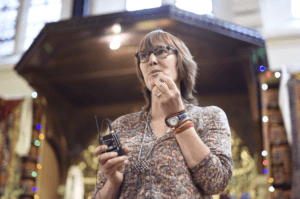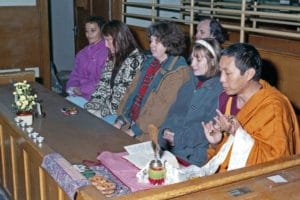Meet Alison a pillar of the Jamyang community.
Since the early days, Alison was a pillar of the Jamyang community. She turned the old courthouse into a vibrant Buddhist centre, she offered her service as a director for Jamyang London and after for the Foundation for Developing Compassion and Wisdom (FDCW). Alison also sat on the FPMT, Inc. board of directors for 10 years and she is now the Chair of Trustees of Jamyang London Buddhist Centre and the Courthouse Community Centre. She is the co-author of the 16 Guidelines for a Happy Life book and app, and she recently compiled and edited the Lamrim Year: Making Life Meaningful Day By Day.
When & how did your Journey with Jamyang begin?
I met Lama Zopa Rinpoche at Kopan Monastery in Kathmandu in December 1987. This was a turning point in my life. For the next few years I lived mostly in Asia and the USA, but when I returned to live and work in London I offered my services to Jamyang as a volunteer. In 1993 Rinpoche asked me to find a new building for Jamyang, which at that point was located in a terraced house in Finsbury Park, North London, and in 1994 he asked me to become executive director.
In November 1995 we purchased The Old Courthouse in Renfrew Road, and I had the great privilege and pleasure of working full-time for the centre from the Spring of 1996 until I stood down in 2004. During this time we also set up the charity Courthouse Community Centre to provide activities and support for the local community and established the Courtyard Café.
In 2018 I accepted an invitation to become a trustee of Jamyang and of the Courthouse Community Centre, and subsequently became chair of both boards.
What does it mean to have a centre like Jamyang in London?
It is very rare to have access to the entire teachings of the Buddha.
We can see that when we look at the world around us. So Jamyang is more special than we can imagine, especially if we think in terms of centuries rather than just months and years. In my experience, these are the most reliable and complete teachings I’ve ever come across for bringing more peace and happiness into my life and the lives of the people around me. Even more so because of the extraordinary qualities of teachers such as Lama Zopa Rinpoche and Geshe Tenzin Namdak who are present in real-time to guide us. Without teachers like this, I would find it extremely hard to stay on the Buddhist path and bring about lasting change in my life.
So Jamyang offers me and many others an unbelievable opportunity. Even though many people don’t have the karma to study the teachings in their traditional form, I have seen how simply visiting the centre, meeting staff and volunteers or encountering holy objects can have a positive effect on the many people who visit the building, use the meeting rooms and B&B, enjoy and café and garden, or even who find themselves at the centre unexpectedly, for example, to work on the building. We can’t see the limits of the positive influence that the centre can have on peoples’ lives.
What does the Jamyang community mean to you?
Jamyang is my spiritual family in the UK. It’s where I connect with other students of Lama Yeshe, Lama Zopa Rinpoche and Osel Torres Hita: to study and practice, to support each other, to offer service, and to do our best to jointly take forward their vision and advice for a happier and more peaceful world.
What are your visions for the future Jamyang community?
My visions for Jamyang are simply to take forward the visions of our teachers to provide Buddhist teachings and study facilities in London and the surrounding area, and to support our community of students. It’s also our aspiration to develop current and new initiatives in areas such as universal education, interfaith activities, community services, inclusivity work and the dialogue between scientists and contemplatives. I hope that Jamyang will remain constantly curious and open to whatever needs it encounters in the local area and find creative and joyful ways to respond to these, wherever possible working in partnership with other like-minded organisations and being an example of compassion and wisdom in action.




